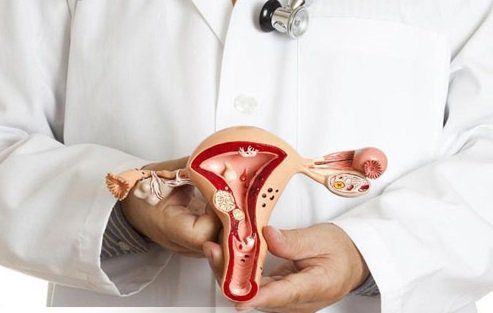This is an automatically translated article.
The article was professionally consulted by Specialist Doctor I Pham Thi Yen - Department of Obstetrics and Gynecology - Vinmec Hai Phong International General Hospital.The vulva, also known as the vagina, is located inside the small labia, below the urethral opening and above the anus, which is the entrance to the vagina. Because it is located in a sensitive position, the vulva sometimes encounters unusual problems, making women feel awkward.
1. What is the vulva?
The vulva (or clitoris) is the external part of the female genitalia. The vulva has a structure that includes:pubic bone Large lip (outer folds) labia minora (inner folds) Outer part of the clitoris, including the glans of the clitoris and the tip of the clitoris; Urethra orifice The entrance to the vagina o Hymen.
2. Vulva changes during puberty
During puberty, the reproductive organs, including the vulva, change in response to an increase in estrogen and other hormones. Small lips grow and open wider. Pubic hair starts to grow a lot. The amount of pubic hair increases over time, becoming thicker and more curly. The color of the vulva can also vary slightly. In adults, the color of the vulva usually varies from pale pink to reddish brown or dark brown.3. What is the normal vulva?
There are many vulva that are completely normal, but the shape and size of the vulva varies from person to person. The small vulva has a large labia about a quarter of an inch wide, while for a large vulva this can be up to 2 inches. Some women have small lips on the big side and small on the side. All of these are normal.4. What to do if the vulva changes color?
If you notice changes in the skin color of your vulva (redness, dark spots, or lightening), including a mole or any swelling, or pain, itching, or burning, be frank. discuss that with your gynecologist at your next visit.5. Signs of vaginal discharge

Normal vaginal discharge is transparent or slightly cloudy white and has no unpleasant odor. An abnormality occurs when you observe a change in the color, smell, volume or nature of the discharge from day to day. Vaginal discharge with an odor is normal. However, if you notice that the discharge in the "girl" has an unusual and unpleasant smell, it is very likely that your vagina has an infection
When you detect an abnormal vaginal discharge, you need to visit See a gynecologist, avoid self-treating at home. Sprays, deodorants, and douches can make the condition worse.
6. The body's vaginal defense mechanism
Estrogen helps make the vaginal lining thick and elastic, creating conditions for the growth of lactobacilli bacteria. This group of bacteria produces a substance that makes the vagina slightly acidic, in order to protect the vagina from pathogenic microorganisms. Besides, yeast also has a role to help protect the vagina. On the other hand, it is thanks to the natural acidic pH of the vagina that yeast strains and microflora cannot grow out of control. However, this balance can be disrupted with yeast infections and vaginitis.7. Yeast Infection in Vagina
Yeast infections are caused by an overgrowth of yeast in the vagina. The cause can be due to the effect of lubricants, spermicides, antibiotics (which destroy the good bacteria in the vagina) or pregnancy.The most common symptoms are vulvar itching and burning. Yeast infections can be treated with an antifungal medication inserted into the vagina (locally acting) or by taking it by mouth (systemic action).
8. Bacterial vaginosis
Bacterial vaginosis occurs when the bacteria that live in the vagina overgrow. The main symptom of vaginitis is an increased discharge with an unpleasant strong odor often described as 'smell of rotten fish'. Vaginitis is treated with antibiotics taken by mouth or placed directly into the vagina.9. Changes in the vulva in different stages of life
9.1. When pregnant
During pregnancy, levels of the hormones estrogen and progesterone increase. Estrogen increases and blood flow to the vaginal area increases, causing your vulva to swell. The skin color at the vulva and vaginal opening is likely to darken. Vaginal discharge is also more than usual. Hormonal changes also cause an imbalance of yeast and bacteria in the vagina. Therefore, the rate of vaginal infections is usually higher for pregnant women.Some pregnant women may experience varicose veins in the vaginal, vulvar and anal areas (commonly called hemorrhoids). However, the condition usually goes away after childbirth.
9.2. After getting pregnant
During childbirth, the perineum area dilates to accommodate the size of the baby's head. Sometimes, the skin and tissues in the perineum are torn. Small lacerations may heal on their own after birth without the need for stitches, but large lacerations may require surgical help.Another problem that can occur after childbirth is vaginal dryness, especially during breastfeeding. Vaginal dryness is caused by changes in hormone levels. To address this, lubricants and estrogen therapy can be used.
9.3. Menopause
Women going through menopause often experience a decrease in estrogen levels, affecting the vagina and urinary tract. Over time, the vaginal lining becomes thinner, drier, and gradually loses its elasticity. Decreased estrogen also causes the lining of the urinary tract to become thinner.In fact, there are many gynecological diseases and abnormal signs occurring in the vulva that women do not always have the conditions to discuss directly with a doctor. Therefore, finding out what knowledge related to the vulva is and related issues are the first steps to help women shape the current status of the vulva before going to the next steps. further decision.
Please dial HOTLINE for more information or register for an appointment HERE. Download MyVinmec app to make appointments faster and to manage your bookings easily.
Reference source: Acog.org.













